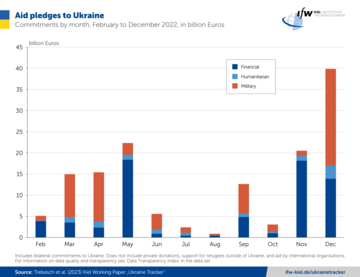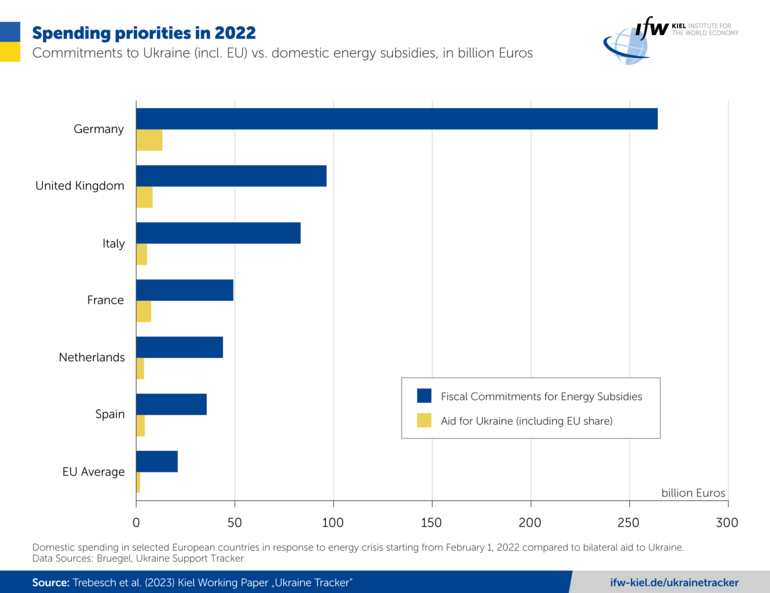News
One Year of Support to Ukraine: US Leads, EU Follows
Over 2022, the US led the way with major support decisions for Ukraine, with EU countries following with some delay and overtaking the US in the meantime with their total commitments. With additional data now collected (November 21 to January 15), the US again takes the lead. With additional pledges of nearly 37 billion euros in December, the Americans have earmarked a total of just over 73.1 billion euros for Ukraine support. For the EU, the comparable figure is 54.9 billion euros. Overall, pledges of humanitarian assistance remained relatively constant over the course of the year, while the share of financial and military support pledges grew. After a strong drop in new pledges in the summer, commitments broke records toward the end of the year.
The tank deliveries of European countries and the US announced after the NATO-Ukraine Contact Group meeting in Ramstein on January 20 are not included in the update of the Ukraine Support Tracker. The commitments of many countries were still too vague for a valid comparison.

"The Americans are setting the pace in supporting Ukraine. The Europeans' hesitancy in the first year of the war is a remarkable phenomenon, especially since financial resources can be quickly mobilized. This is shown, for example, by the vast amount of funds that EU governments mobilized to cushion the energy price shock at home," says Christoph Trebesch, head of the team producing the Ukraine Support Tracker and research center director at the Kiel Institute.
Germany alone has announced up to 264 billion euros in subsidies since January 2022 to cushion the rise in energy prices for consumers and businesses, while support pledges to Ukraine is 6.15 billion euros bilaterally plus 7.2 billion euros indirectly through the EU. That is only about 5 percent of the sum mobilized for energy subsidies. Other EU countries also promised large-scale energy packages, on average ten times of what they committed to Ukraine.
Germany’s transport cost subsidies during the summer of 2022 (gasoline tax rebate and a 9-euro train flat rate) cost about as much (5.65 billion euros) as the bilateral German pledges to Ukraine (6.15 billion euros). Moreover, the government is spending many times that amount on rescuing the energy trading group Uniper (34.5 billion euros) or for its newly announced special military fund to strengthen the German armed forces (100 billion euros).

In the period now additionally covered for the Ukraine Support Tracker (Nov. 21–Jan. 15), the US made the biggest leap forward with new pledges totaling 36.7 billion euros. More than half of this is military support. The UK (1.296 billion euros), France (565 million euros) and Japan (472 million euros) also announced large new packages.
For the first time the Ukraine Support Tracker team also drew historical parallels to earlier wars. This reveals that the cost of supporting Ukraine is far lower than the costs incurred by Western allies in previous conflicts. The United States, for example spent slightly more per year on their expenses in the Afghanistan war after 2001 than on aid to Ukraine, and even more than 3 times as much per year on the Iraq war (measured in percent of GDP).(*) Germany committed more than 3 times as much to Allies in the Gulf War of 1990/91 compared to what it has committed to Ukraine (again measured in percent of GDP).
(*) We corrected the order of magnitude in this sentence and added the Iraq comparison after a revision of the dataset.
About the Ukraine Support Tracker
The Ukraine Support Tracker lists and quantifies military, financial and humanitarian aid pledged to Ukraine since January 24, 2022 (currently through January 15, 2023). It covers 40 countries, specifically the EU member states, other members of the G7, as well as Australia, South Korea, Turkey, Norway, New Zealand, Switzerland, China, Taiwan, and India. Also, EU institutions are included as a separate donor. The tracker lists government-to-government commitments; private donations or those from international organizations such as the IMF are not included in the main database. Flows going into other countries like, for example, Moldova, are not included.
With regard to sources, the database combines official government sources with information from international media. Aid provided in kind, such as medical supplies, food, or military equipment, is quantified on the basis of market prices or information from previous crises involving government aid. In case of doubt, upper bounds of prices are used.
The Ukraine Support Tracker is constantly being expanded, corrected, and improved. Suggestions are very welcome and can be sent to ukrainetracker@ifw-kiel.de.
More information and detailed data can be found on this webpage: Ukraine Support Tracker
